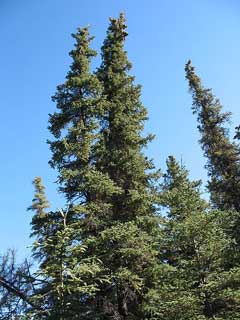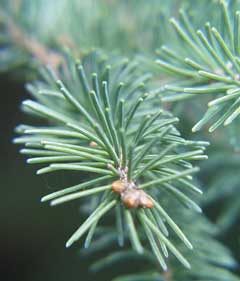 |
|
http://www.flickr.com/people/11360143@N03 |
 |
|
Translate this page:
Summary
Bloom Color: Red, Yellow. Main Bloom Time: Early spring, Late spring, Mid spring. Form: Columnar, Pyramidal.
Physical Characteristics

 Picea glauca is an evergreen Tree growing to 15 m (49ft) by 5 m (16ft) at a fast rate.
Picea glauca is an evergreen Tree growing to 15 m (49ft) by 5 m (16ft) at a fast rate.
See above for USDA hardiness. It is hardy to UK zone 2. It is in leaf all year, and the seeds ripen in September. The species is monoecious (individual flowers are either male or female, but both sexes can be found on the same plant) and is pollinated by Wind.
Suitable for: light (sandy), medium (loamy) and heavy (clay) soils and can grow in heavy clay and nutritionally poor soils. Suitable pH: mildly acid and neutral soils and can grow in very acid soils.
It cannot grow in the shade. It prefers moist or wet soil. The plant can tolerates strong winds but not maritime exposure.
It cannot tolerate atmospheric pollution.
UK Hardiness Map
US Hardiness Map
Synonyms
P. alba.
Plant Habitats
Woodland Garden Canopy; Bog Garden;
Edible Uses
Edible Parts: Flowers Inner bark Seed Seedpod Shoots
Edible Uses: Condiment Gum Tea
Young male catkins - raw or cooked. Used as a flavouring[172]. Immature female cones - cooked. The central portion, when roasted, is sweet and syrupy[172]. The cones are about 5cm long[82]. Inner bark - raw or cooked[257]. It can be dried, ground into a powder and then used as a thickener in soups etc or added to cereals when making bread[172]. Usually harvested in the spring[257], it is an emergency food that is only used when all else fails. Seed - raw[172]. The seed is about 2 - 4mm long[229] and is too small and fiddly to be worthwhile unless you are desperate[172]. A refreshing tea, rich in vitamin C, can be made from the young shoot tips[172]. The trunk yields a gum, used for chewing[183, 257]. Spruce oil, distilled from the leaves and twigs, is used in the food industry to flavour chewing gum, ice cream, soft drinks and sweets[183].
References More on Edible Uses
Medicinal Uses
Plants For A Future can not take any responsibility for any adverse effects from the use of plants. Always seek advice from a professional before using a plant medicinally.
Antiseptic Digestive Diuretic Laxative Pectoral Poultice Salve Skin
TB Urinary Vitamin C
White spruce was widely employed medicinally by several native North American Indian tribes, who valued it especially for treating chest complaints[257]. It is little, if at all, used in modern herbalism. An infusion of the cones has been used in the treatment of urinary troubles[257]. The inner bark is pectoral[257]. It has been chewed, and an infusion drunk, in the treatment of TB, influenza, coughs and colds[257]. An infusion is also drunk in the treatment of rheumatism[257]. The inner bark has also been used as a poultice on sores and infected areas, and has also been used to bandage cuts[257]. The tea made from the young shoot tips has antiseptic properties[226]. It is used in the treatment of respiratory infections[257]. A decoction of the stems is used as a herbal steam bath in the treatment of rheumatism[257]. The gum is antiseptic, digestive, laxative, pectoral and salve[257]. A decoction has been used in the treatment of respiratory complaints[257]. The gum obtained from the trunk (probably pitch[K]) has been used as a salve on sores and cuts[257]. A poultice of the gum mixed with oil has been used to treat skin rashes, scabies, persistent scabs, growing boils etc, and has also been used on wounds where there is blood poisoning[257]. The rotten, dried, finely powdered wood has been used as a baby powder and as a treatment for skin rashes[257].
References More on Medicinal Uses
The Bookshop: Edible Plant Books
Our Latest books on Perennial Plants For Food Forests and Permaculture Gardens in paperback or digital formats.

Edible Tropical Plants
Food Forest Plants for Hotter Conditions: 250+ Plants For Tropical Food Forests & Permaculture Gardens.
More

Edible Temperate Plants
Plants for Your Food Forest: 500 Plants for Temperate Food Forests & Permaculture Gardens.
More

More Books
PFAF have eight books available in paperback and digital formats. Browse the shop for more information.
Shop Now
Other Uses
Baby care Dye Gum Musical Pitch Repellent Shelterbelt String Tannin Waterproofing Wood
A fairly wind resistant tree, it can be grown as part of a shelterbelt planting[200]. The cultivar 'Denstat' has been recommended[200]. The leaves have been burnt to repel insects[257]. Various native North American Indian tribes made a string from the long roots of this species and used it to stitch the bark of their canoes and to make baskets etc[226, 257]. The rotten, dried, finely powdered wood has been used as a baby powder and as a treatment for skin rashes[257]. The bark is a source of tannin[226]. A yellow-brown dye can be obtained from the rotten wood[257]. The pitch obtained from the trunk can be used as a waterproofing sealant in canoes[257]. Wood - straight-grained, resilient, light, soft, not strong. Used for construction and as a source of pulp for paper making[46, 61, 171, 229]. The resonance of the wood, and its capacity to transmit vibrations, make it an ideal wood for guitars, violins, piano soundboards etc[226].
Special Uses
Scented Plants
References More on Other Uses
Cultivation details
Landscape Uses:Christmas tree, Firewood, Screen, Specimen. Likes abundant moisture at the roots, if grown in drier areas it must be given a deep moist soil[11]. Tolerates poor peaty soils[200]. Succeeds in wet cold and shallow soils but is not very wind-firm in shallow soils[1]. Prefers a pH between 4 to 6[200]. Dislikes shade[200]. Intolerant of atmospheric pollution[11]. Resists wind exposure to some degree[200]. A fast growing tree, especially when young with annual increases of up to 1 metre in height[185]. New growth takes place from April to July. Growth slows considerably as the trees grow older[185]. It is an important forestry tree in N. America and is also planted for timber in N. Europe. It is sometimes used as a 'Christmas tree', but is unsuited for this because its leaves quickly fall[226]. Seed production begins at approximately 20 years, though reliable crops make take twice that long[229]. Heavy crops are produced every 2 - 5 years[229]. Trees should be planted into their permanent positions when they are quite small, between 30 and 90cm. Larger trees will check badly and hardly put on any growth for several years. This also badly affects root development and wind resistance[200]. In some upland areas, especially over granitic or other base-poor soils, growth rate and health have been seriously affected by aluminium poisoning induced by acid rain[200]. Plants are strongly outbreeding, self-fertilized seed usually grows poorly[200]. They hybridize freely with other members of this genus[200]. There are some named varieties selected for their ornamental value[200]. The crushed leaves are quite aromatic. Some people find the smell distasteful saying that it is like skunks[226], whilst others say it has a pleasant smell like blackcurrants or mouldy grapefruit[185]. Special Features:North American native, Inconspicuous flowers or blooms.
References Carbon Farming Information and Carbon Sequestration Information
Temperature Converter
Type a value in the Celsius field to convert the value to Fahrenheit:
Fahrenheit:
The PFAF Bookshop
Plants For A Future have a number of books available in paperback and digital form. Book titles include Edible Plants, Edible Perennials, Edible Trees,Edible Shrubs, Woodland Gardening, and Temperate Food Forest Plants. Our new book is Food Forest Plants For Hotter Conditions (Tropical and Sub-Tropical).
Shop Now
Plant Propagation
Seed - stratification will probably improve germination so sow fresh seed in the autumn in a cold frame if possible[80]. Sow stored seed as early in the year as possible in a cold frame[78]. A position in light shade is probably best[78]. Seed should not be allowed to dry out and should be stored in a cool place[80]. Prick out the seedlings into individual pots when they are large enough to handle and grow them on in the greenhouse or cold frame for their first winter. They can be planted out into their permanent positions in early summer of the following year, or be placed in an outdoor nursery bed for a year or so to increase in size. They might need protection from spring frosts. Cuttings of semi-ripe terminal shoots, 5 - 8cm long, August in a frame. Protect from frost. Forms roots in the spring[78]. Cuttings of mature terminal shoots, 5 - 10cm long, September/October in a cold frame. Takes 12 months[78]. Cuttings of soft to semi-ripe wood, early summer in a frame. Slow but sure.
Other Names
If available other names are mentioned here
Native Plant Search
Search over 900 plants ideal for food forests and permaculture gardens. Filter to search native plants to your area. The plants selected are the plants in our book 'Plants For Your Food Forest: 500 Plants for Temperate Food Forests and Permaculture Gardens, as well as plants chosen for our forthcoming related books for Tropical/Hot Wet Climates and Mediterranean/Hot Dry Climates. Native Plant Search
Found In
Countries where the plant has been found are listed here if the information is available
Weed Potential
Right plant wrong place. We are currently updating this section.
Please note that a plant may be invasive in one area but may not in your area so it’s worth checking.
Conservation Status
IUCN Red List of Threatened Plants Status :

Growth: S = slow M = medium F = fast. Soil: L = light (sandy) M = medium H = heavy (clay). pH: A = acid N = neutral B = basic (alkaline). Shade: F = full shade S = semi-shade N = no shade. Moisture: D = dry M = Moist We = wet Wa = water.

Expert comment
Author
(Moench.)Voss.
Botanical References
1143200
Links / References
For a list of references used on this page please go here
Readers comment
| Add a comment |
|
If you have important information about this plant that may help other users please add a comment or link below. Only comments or links that are felt to be directly relevant to a plant will be included. If you think a comment/link or information contained on this page is inaccurate or misleading we would welcome your feedback at [email protected]. If you have questions about a plant please use the Forum on this website as we do not have the resources to answer questions ourselves.
* Please note: the comments by website users are not necessarily those held by PFAF and may give misleading or inaccurate information.
To leave a comment please Register or login here All comments need to be approved so will not appear immediately.
|
|